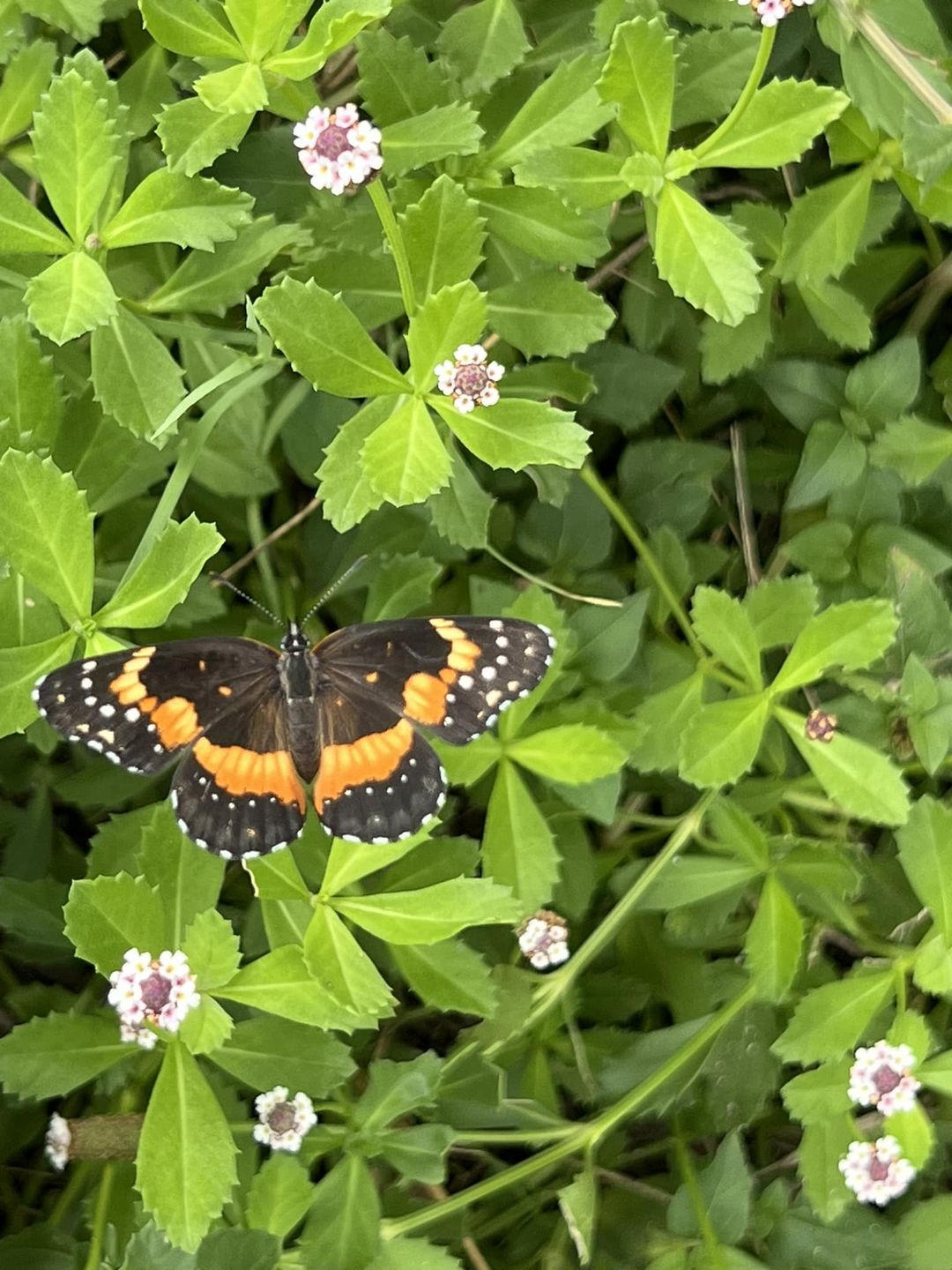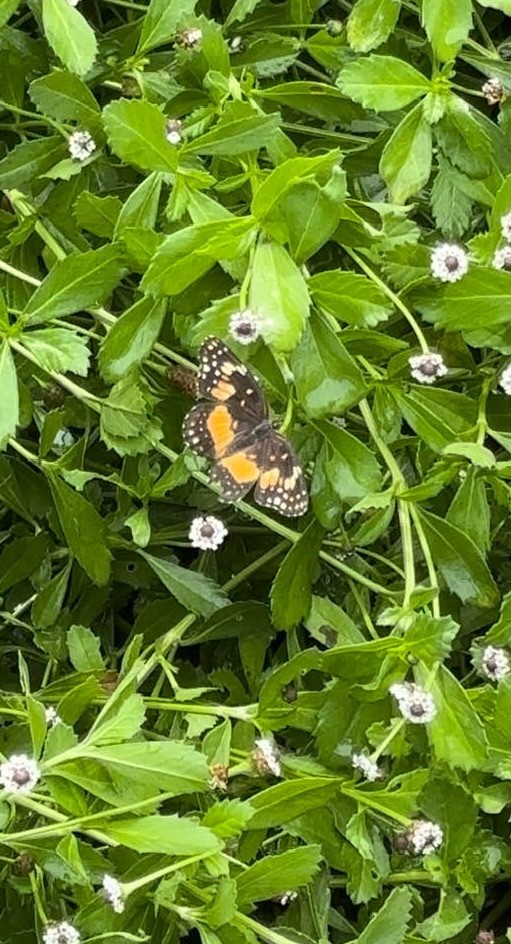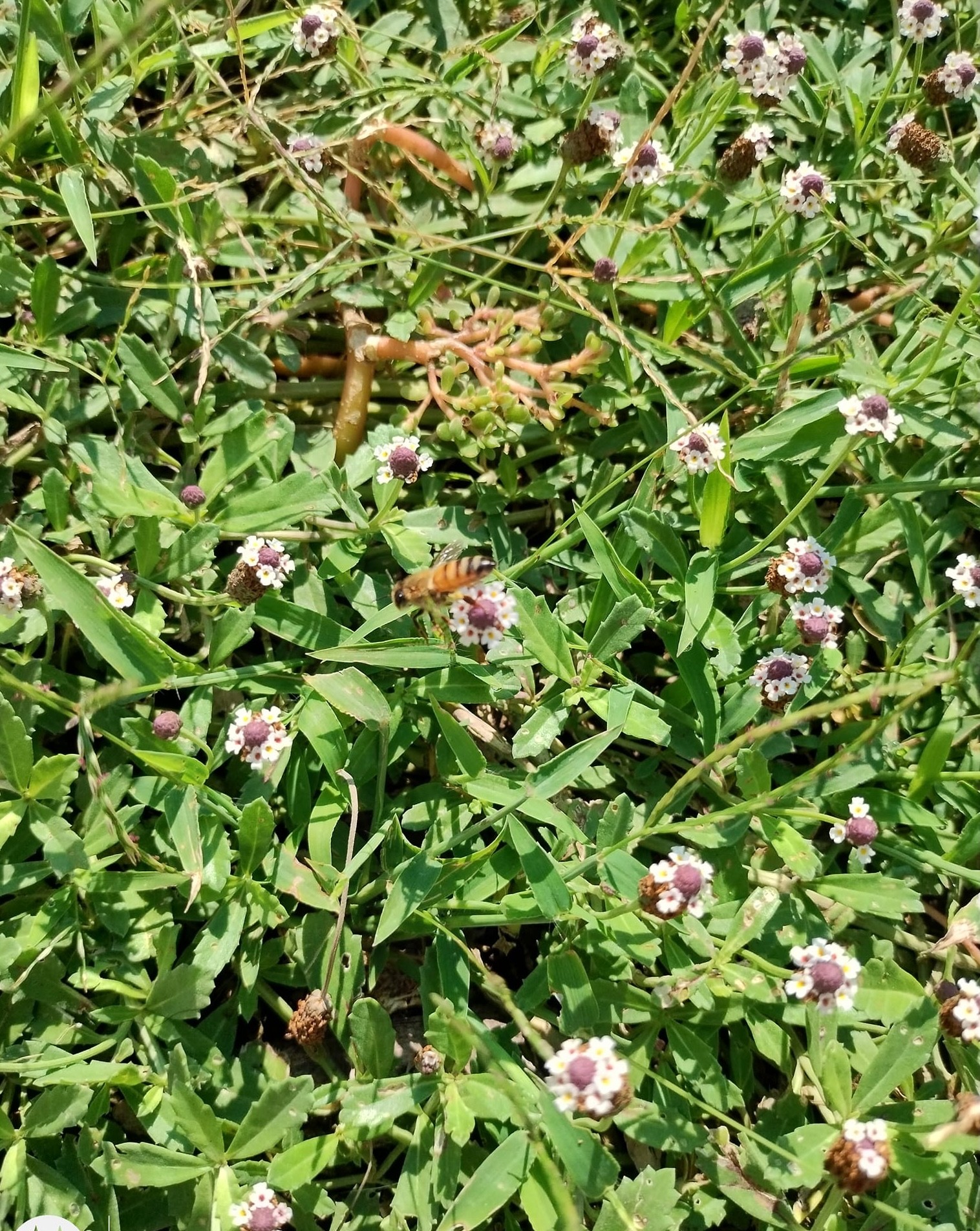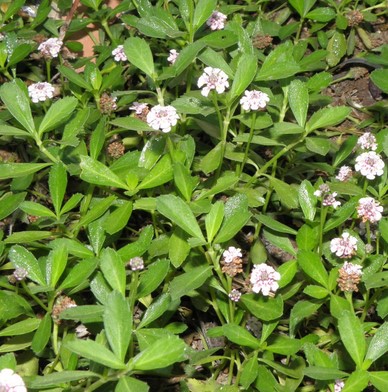Are you looking to move away from the conventional turf grass into a more sustainable ground cover? Well, here’s an idea: try Frog Fruit. This flowering plant is remarkably low-maintenance, and unlike lawn grass, it thrives with minimal intervention.
Frog fruit is as practical as it is stunning and will work great for your outdoors, whether you wish to use it to cover a few bare patches or your entire lawn.
Let’s take a deep dive into this fantastic plant, exploring its benefits and how to grow it correctly.
What Is Frog Fruit Ground Cover?
Overview
- Botanical Name: Phyla nodiflora
- Plant Type: Perennial, Ground Cover
- Family: Verbenaceae
- Size: 4-8 inches tall, up to 4 feet spread
- Hardiness zones: 7-11
Frog fruit also goes by names like turkey tangle, and matchweed. This plant adapts to a wide range of growing conditions, including partial shade, but prefers full sun. Frog fruits are deer-resistant and aren’t toxic to dogs.
It is also not picky regarding soil types, thriving in sand, clay, loam, and even compacted, alkaline, or poor soils. Frog fruit also tolerates drought, which makes it a practical choice if your area experiences hot, dry summers or you want to conserve water.
It can handle temperatures above 90°F. However, it doesn’t do so well in the cold. It dies in winter, but don’t worry, it usually returns in spring.
Related Posts:
Frog fruits spread horizontally through runners, creating a dense mat comprising small, bright green, slightly serrated, and oval-shaped leaves that give it a fine texture. In late spring, this plant produces little flower clusters in white or pale purple colors that persist throughout summer and fall.
Consider frog fruit if you want to cover a large bare ground with lush ground cover, fill in gaps between stepping stones, pavers, or in rock gardens, and even create a soft, green carpet under trees. It is also ideal for commercial areas, parks, and public spaces.
It’s native to the states below:
- Georgia
- Alabama
- Kansas
- Arkansas
- Kansas
- Kentucky
- Arizona
- Florida
- California
- Hawaii
- Nevada
- Lousiana
- Maryland
- New Mexico
- Missouri
- North Carolina
- Mississippi
- Utah
- Oklahoma
- Texas
- Oregon
- Virginia
- South Carolina
- Pennsylvania
Pros of Frog Fruit As A Ground Cover
Below are compelling reasons to use frog fruit as ground cover for your lawn.
1. It Grows Fast
Frog fruit is perfect for your lawn if you want to cover bare spaces quickly. This plant grows exceptionally quickly; some may even say aggressively. If you are worried about it taking over the area, you can always trim it back or even pull it out.
2. Low Maintenance
You don’t need to mow frog fruit regularly since it grows low and tidily. In addition, mature frog fruits can tolerate drought and only require minimal watering, so you don’t have to spend much time or water irrigating your lawn.
For this reason, consider frog fruit for xeriscaping or low-water landscapes. Besides reducing your lawn’s watering needs, this plant doesn’t need fertilizing. You can keep this plant healthy without much intervention since it has low susceptibility to pests and diseases and suppresses weeds by outcompeting other plants for resources.
In addition, you don’t need to replant it regularly because it self-spreads rapidly.
3. It Helps Control Erosion
Frog fruit’s fibrous roots bind the soil in areas it grows in, thus stabilizing the ground, while its dense mat prevents runoff during heavy rains or strong winds. Use this plant to prevent soil loss and stabilize the soil in areas prone to erosion, such as garden beds, retaining walls or embankments, and pathways.
4. It’s Highly Adaptable
You can grow frog fruit in the most adverse environments and witness it thriving. It is not fuzzy about the soil conditions, flourishing in nutrient-deficient and poor to compact soils. That’s not all; while frog fruit prefers well-drained soils, it tolerates occasionally wet soil.
When it comes to light, frog fruit grows and flowers optimally in full sunlight. However, it is still a reliable groundcover for partially shaded areas but its growth will be less vigorous. Hot, dry summers are not a match for frog fruit as it is highly tolerant to high temperatures.
5. It’s Aesthetically Pleasing
You can rely on frog fruit to make your outdoor spaces attractive, complementing both hard and softscape elements. You are especially fortunate if your region is warm and doesn’t experience harsh winters because this plant will stay evergreen.
A frog fruit lawn is lush, neat, dense, and carpet-like. Your lawn will look lovely from May to October when it flowers. The foliage’s smooth texture contrasts nicely with the surroundings.
6. Pollinators Love It
The nectar produced by frog fruits helps sustain pollinators from late spring to fall when they bloom. This beautiful plant will make your home appealing to bees and butterflies, among other beneficial insects. Frog fruit is also a host for three butterfly species: white peacock, phaon crescent, and common buckeye.
7. Long Blooming Period
The fact that frog fruit flowers is amazing. It gets better; its flowering period is from May to October. Aside from ensuring your spaces look stunning and full of life for a long period, pollinators get a steady supply of nectar for several months.
8. It Handles Foot Traffic
This ground cover can handle moderate foot traffic without significant damage and easily recovers from occasional use. This means you can grow frog fruit in areas like garden beds, between stepping stones, and around pathways.
You can also use it on your lawn but protect it from heavy foot traffic (installing stepping stones can help reduce direct contact with the frog fruit). Alternatively, combine it with ground covers that can withstand heavy foot traffic.
9. It’s Cost Effective
Frog fruit is a budget-friendly lawn alternative; it is affordable to install and has low maintenance costs. Buying this plant’s seeds, small plants, or plugs is inexpensive, so you can cover a large area without spending much money.
You also don’t need to replant it yearly because frog fruit is a perennial.
10. It’s Eco-Friendly
Frog fruit is healthier for the environment than traditional lawn grasses because it doesn’t need fertilizers, pesticides, herbicides, or much watering. It also enhances local biodiversity by giving pollinators nectar and providing forage and habitat to small wildlife.
Cons of Frog Fruit Lawn
a) Not Ideal for Heavy Foot Traffic
While it can handle moderate foot traffic, it’s not as durable as traditional turf grass for high-traffic areas such as playgrounds or sports fields.
b) Seasonal Appearance
Frog fruit may go dormant in colder months, turning brown or dying back, which can leave the lawn looking less attractive in winter.
c) Invasive Potential
In some regions, frog fruit can spread aggressively if not managed. This can be an issue if it starts encroaching into flower beds or other areas where you don’t want it to grow.
d) Tends to Grow Unevenly
Frog fruit can grow in patches, and in some cases, might need more time to establish a uniform appearance compared to traditional grass lawns.
e) Limited Availability
Depending on where you live, frog fruit may not be as readily available in nurseries or garden centers as other lawn alternatives, which could make it more challenging to source.
f) Weed Control
In some cases, weeds can grow through a frog fruit lawn, requiring occasional maintenance to keep it looking neat.
How To Grow Frog Fruit As A Ground Cover
So, you’ve decided to switch your lawn to frog fruit or add it to some sections. Well, let’s go through the steps to grow it.
a) Site Preparation
Frog fruit can grow anywhere, but choose a place with well-draining soil, full sun to partial shade, and moderate foot traffic for the best results. Before planting frog fruits, site preparation is essential as it will give your plants the best chance to take root, grow, spread, and flourish.
Below is what’s on your to-do list:
- Remove debris and unwanted vegetation. These include weeds, rocks, dead sod, and bushes. Remove the existing grass if you are replacing your lawn with frog fruit ground cover. You can smother them with sunlight or remove them with a sod cutter or shovel.
- Till the area; this will aerate the soil and clean it of remaining twigs, rocks, weeds, sticks, and other debris.
Spread fresh topsoil and rake until the area is as flat and smooth as possible. Make sure the place doesn’t have mounds and divots to avoid scalping the lawn or tripping hazards.
b) Planting
The procedure of planting frog fruits depends on the method you choose. Below are your options:
- Seeds
Scatter frog fruit seeds evenly over the soil you’ve already prepared and cover them with mulch or soil.
- Plugs
Dig holes 12 to 18 inches apart that are larger than the plugs’ root balls. Place the plug in the holes (every plug gets its hole) and backfill them with soil. Ensure the plug’s root ball and the surrounding soil are at the same level.
- Cuttings
Take 4-6 inches of cuttings from healthy frog fruit stems and expose the nodes by removing the lower leaves. Plant the cuttings directly on the ground, burying at least two nodes underground. Alternatively, plant them in pots until they develop roots, then transfer them to the ground.
c) Watering
Water your lawn immediately after sowing frog fruit seeds or planting plugs or cuttings to help the soil settle. After that, water them daily or every other day until you see new growth and the frog fruit plants begin spreading.
d) Maintenance
Your lawn will need help tackling weeds before frog fruits mature, so until then, provide ongoing weed control. If your frog fruit plants become leggy, trim them and prune any edges that creep into areas you don’t want this plant.
While not necessary, you can mow frog fruit. If you choose to do so, do it after the last flowers die before the first frost appears. Apply liquid bloom fertilizer every spring to encourage more flowers.
Conclusion
Highly adaptable, low-maintenance, resilient, drought-tolerant, eco-friendly, pollinator-friendly, cost-effective, durable and aesthetically appealing. These qualities make frog fruit an excellent ground cover for your lawn. It can withstand changing seasons and even a bit of abuse. You can depend on frog fruit to provide ground cover for years.

Hey there, I’m Derek Schew, a writer for Lawnholic.com, where we cover everything and anything related to lawns. As someone who’s spent countless hours tending to my own lawn, I’m passionate about sharing my knowledge and helping others achieve the perfect yard. From lawn care tips to product reviews, I’m committed to providing our readers with the most accurate and up-to-date information available. So whether you’re a seasoned lawn enthusiast or just getting started, I invite you to join our community and discover the joys of a lush, green lawn.




